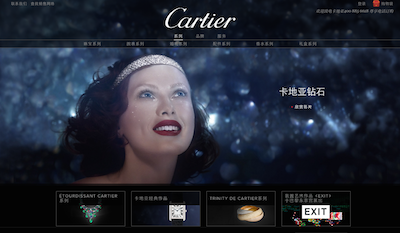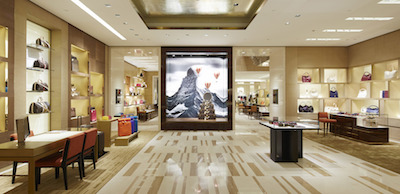A number of luxury brands have launched ecommerce sites in China within the past year, but online shopping still feels like risky business to many of the country’s consumers, according to a new report by FDKG.
FDKG's "Luxury Insights China 4th Quarter" report explains that with less regulation of online sales in China, consumers may have to endure a drawn out dispute if items are not delivered as promised, making each purchase a consideration of not only spending budget, but a weighing of how much can comfortably be lost. While some may still opt for an in-store purchase, a growing interest in online shopping within China is evident in the $14 billion in transactions during Single’s Day Nov. 11.
Balancing act
Luxury brands traditionally eschewed online channels, believing that they would risk eroding their brand positioning. Because of this, luxury labels that have opened online selling in China, such as Cartier, have tended to do so quietly.
Cartier sent out a single WeChat message to its followers, choosing to keep the news within the community it has developed on the platform.

Cartier Chinese ecommerce site
While luxury brands traditionally dealt in exclusivity and serving the few through their boutiques, this only works when sales are strong. Having an ecommerce site that lists prices may help make infrequent or first-time buyers feel comfortable walking into a store.
Transparency may also spur local purchases, if a Chinese consumer can see that the price does not differ much between their city’s boutique and one in Europe.
As far as consumers’ comfort in shopping online, Luxury Insights China references a survey by KPMG, which revealed that for products under 4,200 RMB, or about $641, they felt confident making a purchase online. This was up from 1,200 RMB the year before.
When shopping online, the Chinese consumer prefers cash on delivery as her payment method, allowing her to know she got what she ordered before shelling out money. However, the most preferred purchase path is still going to a store to pick up an item, since it removes any uncertainty from the process.

Image courtesy of Peninsula
With the right incentive, Chinese consumers will choose to spend online. Nov. 11, on which the shopping holiday Singles’ Day is celebrated, broke records. Over 24 hours, Alibaba saw $14 billion in sales, a 60 percent growth from the previous year.
Alibaba’s Tmall created Singles’ Day seven years ago as an excuse for those without significant others to treat themselves. Playing into the deal-loving nature of Chinese shoppers, the day boasts extensive sales across categories, expanding to include even automobiles, apartments and furniture.
Consumers often wait specifically for the 30, 40 or 60 percent discount to drop the price on items they eyed earlier online.
This year, a number of U.S. retailers joined the action through a partnership with Dealmoon (see story). Indeed, the U.S. was the top import country during Singles’ Day, followed by Japan and Korea.

Michael Kors' promotional image for Singles' Day
Online and offline shopping has also gotten easier in China thanks to Alipay, Alibaba’s finance division, which has become a preferred payment method. Chinese consumers can link up their bank account to Alipay by using their mobile phone, and then use it as payment.
To further spur Alipay use, Alibaba launched a follow-up holiday Double 12, held on Dec. 12. Again reaching out to bargain-loving consumers, the day promises discounts at stores, restaurants, movie theaters and more when they use Alipay to complete the transaction.
While this worked to draw out the millennial crowd, more than 900,000 of the 28 million purchasers on Double 12 were in their 50s or older, many of whom learned how to use Alipay specifically to participate.
In general, the mobile phone is replacing the wallet in China due to its simplicity.

Alipay
Having an ecommerce site to serve the whole country is also more cost effective than opening stores in every potential market. Because of the rise in ecommerce, a number of brands, including Armani, Ferragamo and Chanel, have reduced the number of storefronts they operate in the country, finding the right balance between in-store and online.
Going north
Shenyang, a city in the northeast of China, has the third highest number of luxury stores in China despite a weaker economy than other Chinese cities.
In the 1970s, the Liaoning province, of which Shenyang is the capital, saw an industry value added of 9.3 percent, making it second among all provinces in China. With added affluence, Shanyang became a prime destination for luxury brand stores and malls.
Today, 100 luxury stores sit on one four-mile street known as The Golden Corridor, but this may change.
Liaoning’s industry value added in 2014 was only 4.5 percent, partly a result of industry growth across the nation and also due to the nation’s shift away from heavy industry as it invests more in service and finance.
Louis Vuitton, which had four stores along The Golden Corridor, has not renewed its lease for its oldest boutique in Shenyang. Other retailers, including Dior and Burberry, have simply chosen to move to a different part of the city, showing they still have faith in the capital.

Interior of Louis Vuitton store in Shenyang
Four different international mall operators have left the city since 2010, after many had trouble keeping their storefronts occupied.
Consumers may travel up to two hours to shop in Shenyang, since it has a high density of luxury stores.
These shoppers behave differently than their southern counterparts. Whereas coastal consumers might weigh a luxury purchase heavily, those in Shenyang make decisions more quickly, since their purchases are more often driven by a desire to keep up with the crowd.
This may shift, as the younger generation especially becomes more sophisticated and informed through the Internet. Rather than buying big logos for status, they are more open to lesser-known brands.
Shifting strategy
Even with a faltering economy, Chinese consumption is projected to rise $2.3 trillion by 2020, according to new research by Boston Consulting Group and AliResearch Institute.
Households with disposable incomes of $24,000 or more will drive 81 percent of consumption growth through 2020, creating demand for high-end goods and services. With rising incomes, a younger generation gaining spending power and growing ecommerce expenditures, brands will need to adjust their strategies (see story).
The Chinese market is complex and ever-evolving, requiring international luxury brands to practice patience and due diligence if they want to enter and remain successful in this environment, according to a report by CR Retail.
While some retailers are quick to blame China’s anti-graft measures for their lack of success in the industry, ultimately failure is often the result of lack of research and an inability to understand the complexities of the market. In order to be successful in China, luxury brands must adapt to consumer preferences and target retail and marketing strategies to appeal to the Chinese consumer (see story).
Final Take
Sarah Jones, staff reporter on Luxury Daily, New York
{"ct":"DfP7EyVH5tEOfOK76eswPtfWVqymbW2gPkep8pt9kytbuLEXcBhPEh9CCrYQWVb3V2PO5u7IY5qHKdnEk2R7H5IRvnAQslXgYJ7is+taGWIH5MtfXyRh8IM49lhAylWbS19xXzPM\/edQ2MoF3sXjOdvQdqc9T0YPxHAnLnTGv503RLgVQhv9aQkJmSBLd09dGuMKnGMcRRZ8sll+1p1mI7HvCcuWuduXl3EcuhdgXM6LOPhj39yIMQtrAg6Nstx\/BOpmXCYQ4QGsjesIt5MNrNebO0i+Mu7FjGvps\/uvdtE8mexSPT2dTMhsvfIN8jsuZICnv\/Z94PrX6CpktMejkNgbKeKXWGBDEfUCB6JetrEa9DF4+AsDQ22yU61dD9L0IqmUhsachrm\/kNccR9TEzXzbGZVGhyalfV7qav+rGkkF7yUq47uu4LlkoI4YU2MH0IC7DFQK3zzC9AwYba2RyOc\/s8+lTwBG3ZH8Bcx6IEFu055JIJh5xGmGO5gFBwIwb6X2GrGPo40MJa5gpBJoONTPaoiGPI4KHAIrmv5TV+dbxdrlZQKPgT70DrW6UcOLaj1Yiyv4DcCmC2783JTMGUcJvtuf1K\/LOHghNLD7K5Exx6fPscrOL7hIr160braJ1uUKx0au5n9fy4\/SQV+xQF396kwsmqJSSNJtV1y\/Gksjv6kS1O+8yEWy6T1lVUGiKRykHXPX9VlSdtMf5EOARikBMjYnlhkQ\/dICGyl0PZqBbEFauZkAfOTMo\/CjMdRZaXu5KY3JBxp9EG5cn1Ssz7LxUYk+SJcAuFazEb682447SwLsaao6sVZ5mYlCSB3NjErNhUfrQdkeePEu35H3ELfEQe5WyNK9fz2FkD6NkKN6Bad1VwE18uqOOfToemkYZZQkHKLgrdFmF\/gVNgkic7KAJrLragM4veLnyf79ZRAjaTf0QM1eel8sT40t0asrLD4AG6XxT3HuZCBXKySK\/oz8yYrVAotx1fKeG6PU6L0skMFLUbobWjQZddZHohJ5qQvHe8cHZapb67hjy1fJ59U6WC7hf7hORDLGjKfNEHX8tkR+4hWqi6zupZ36EcjsH3g+Ny4YHatMGpNPcTotqZufrVVKmEdmjbTz6te8IGNTswXOjjLCsWDZK\/FiIW6pEAzV8X3xPXPLw7sp9CzaGwAlZjIo4iNUq86qjIciuT1YYeahx3nwvv6Zt+PmQ6HpQ5xTVioXNkRi3uItAN9JlZNL8u3zS6pdDXKODyqb1GTLhYASn47b2G\/NIAf3xvUdWUFGspuiyckXgTI\/k+S8y+8\/6s9YAP4Eu2iWodRc9CIMizxRQHBA7Meu05xEzw\/uiXy3mZ698Bu0WG+49WP6T18o7qC8Z52HMd\/SPNIZDlV5ccf3gp9ZNqmzQkBCCDJHCRvlsAK4IjoVvMHnBj8i7ZkCC0Qqg1peHaXdOK3UVoGthPkSMCFsx24M5z2t+KfpnEbeYe3CPcSTmXqKWJuk5XP2dCgHyg9FA0RPDd+s7WPhngnVneT8XeOo4pZddnyo19Pckn1d6JyJcAUW5oFE9K5c9IJdFqYzFs3XIF8dCyyjJ5lcOS3UxaqxM7N+kWr4pS2wT\/A5Yc8Ycv4Wahqyofjb4KaIMfcOqMqvRWTr\/qJgZ940dr8oJdge2VQWaiZgsAQGuBK0borezz4uAigO1FtpRgYfWgV9eG\/387ohFulKJjpoHof\/Q+BoySJbDxakG2KTlu7gQguY1pqy+D4JSPehjSoWYxo9ohvZYxzQs4fB3KdLrrYNV\/WNU\/tuZsfjavmRnYxtmyhQkgNP9JwrAo\/kbzI6YkVRzNkUN6xdm8u0dndkyfBE1Tlt6T7+NgtCZ3R5xI75t1Nn7FgNKjkwLFRy\/FK+Jv+WP9uWTE6aYOooyZ4hZzEQ0hkQmD1hVbOhdkxBJLP8kBTAkxPkZ8A45PAwhrkcCm+9cN1S9hjGoe0AAx5p22aLpWIlKO9nI58jAghs4ahixNNp6MsuhXwW4Sfvf2NGqcGvQRcSANove96PthnEFvdAXlmAxQapE4gIsFxDqE7x9NPCJzyFl4PjO+qOIRbbKih6n4\/Pgi6D2S4vOn4fs0FoipDoq88XC\/Rb\/P4CLA38FSQM\/0LC9qPd6lZ0z1w2AYLLvZRw4VIrkYWMYrU1Ki70U3b9\/HlVVeBgb78yD\/cBrvi\/GXlDhRS5FPXspJ4hMR2O\/4hxHmN895QRDjr1OXf9iV6uQQY\/j4hHrpL5XhiZk07vEAUy3ZZyZJpLTUZ8g\/HnAMahUeiwqD967Q7mveIQFuVnEqqvbTR0NX6xylzp3VzMBebTt8PRESoomAQGFYlqGKarRlJC8jpII+U1ijrAjFpLKdF9XpWMb+XR3LbDffRt2qfPZ6mz\/KcBe7VhTUPrIfYKKRBeDMNK3egaKgnUlt\/QSGmSWoYyE+ViQ96+ossM+f0Lhmzx+8b1ovfKqR7LDBypUs6d6\/W9qBV1glp44A9xylnvH0BPcfWqc05GYWnJlEbzoZJmKrcxTIJEpoJ9g1651R47dvdgLJ3VZ7tlDelz62a1ingbNF\/DXDiy92bX+R2FdHcGxjfVuKbUIzmt83MuVlpOObT0INDiSTJlRQHLHqPoVYe9HnQzhlqkOBpK7mJEf8NZ2gKyOr+9atgsxKjh1FZXqQrbXQDs9nUtUs4HFQEx0FdlI4ZJhiPKNVp0VjbDYIbxK04+esz5oNFFCB2+EP04koDHW00GTK9N8BXUKpP5+co+XzppqT4pLkTk5OGlj\/eV14yMf+fKwT3pNAseLhzgREjlC9Q\/Aqdd8hEmsv0icNgYBmVsSSDbIwtuv\/v8dqKf7AAj5KXpZsWCZP3DMPJkffVBRNHFgBH1Si7jOrFtwSxe7RR3q9wySSh65TsJo0tuWo58TONwmM+sSbWJlyigU635S27IDAGpPNCJsCbCI5WvXJdJIVVzMPCpVy9d2H4E+nehcJd6vy7VBTKQvHYNFh3ERE0hn9ayMU5L1SAxyNrT8EgFeZJrIBvT0Wh\/hm1PkQstQY\/ScV1y5a5B7jP3vpY1B5KvPCK7qHcJbS\/3w8llDvV1LI8M3PH2oaPEfx53B96J6VVCXK3Z5e1LJxd23ImJl3t3KZS1ETvyBMzSY4hJXQfUF5\/LVGFe494rolgKc2SnGZ1HaiTbZreEPS9psWJczw0Fz+zxHoG3daO9oqWy4fCyJpFg35H+JFXmcXJEIub\/ESYRghl9zt8aLqk8BSqSX0dUw4FoavdhixTtyc9ChGPAIZJibF7hCA9XAtSRpu\/mBRxMVB4LAe\/MJB7St3qnTzuGRp9t9Wm+yTlSn7L5IjT5wTp2u5HfsfV17PuAH8X4ITiIK40SXA77KVa+o779+lnqVpI0dDp7++YpnStFsuKmeK6JtH2jchkzVpaNMBPp0ph+g8e\/DRtLcvep8DhIZi0c8TI0pJ5EuLp1imHF25PPIiRksslwtAS\/7NXdLh6w46SUorOmLYPMqFdVxhCg2XcEeGtx82bHbx0TtMRiwREq\/MQYj0jQMKlVikYcdVCknGuiImzLDJZ9gWh4ZO1SpeTj0JPqSfO1ObxPKf4plVttndISS\/10Oaa7xGS4gCfc8V9hFVCLckbXLhbBFQgFjmCcKExx+eX0RlupIz1gjLpgB9faM6xctJjESuPR0Cmhp\/khvxMhLiJoevUtAWjp7pNz5WHIbzoVq6Y7vj0Zj7OmjQ+WpvRs9vJv5CiVL+h6QUJ8wbB8PVMDxZOmL20LozWzI4rxUVLaoArNLdQeVEUDcKFdmtYGuA5ERjDma4McypygghbviPPKGiw1NVLJZO8+RWdx2ukVFMKD\/td119aRvDmI8Pwgw5sl7cykLTFO04QMDsaR+iERtHBiWuxaaY2FUdbbOOWfzkmwTS0KykNItcy6QPW41+pBEoXD83ur6Vt2O+ZS1SB9vINzlvHDKFkizK6CZ1MA17BADY134RqT5z5avhci7MhfykHLGWN+Cql5+V+TU7mgSFC9Y6thRbuCc3YJPzDD4agTT8KDGPReMnaGTmGaJvyWwJqJvO8Lb2D5\/m8Ad587BSJYIWanLkHscjcSj4dHIfCLhAex+ndti+5uA9iEcGRVXEwO9MAcnVejgLZNkewmwX3BexDcRx2beaOpLtgruyj8aAF8CuZdyy3JEHYh9cqYha1qWHk8k2Zdk5tQ+mav2h6DGbGOCCNCpZkW97\/8kWaS2RRTg5WhanW0DKPOIMPdypJeADx3zZbxQZ9fyDUznLL1EupNUxytF3tlmqW7fl539P2q8un\/++kgWqEnLMsPzSdnbaTlRrYLXiAcjSv66rxzC9gU\/0e69jk0aRjurH03l9vHVeFXiPFFJ2qVL4ny5P\/3c17GTSnJKVOTeEZKMD4FutRGKtm\/+r4Uds8ZOCDabd2kClFPC75S2e4mp+uJluPWGAesunQMRxP9OwAjg28YkZQyMQ6dq0\/7vNeNQBmAh9AGYDFjNpS9moGDlhWxLY8ZLEfIsoieDSGFH7ftYe9K9l1ZykSzqL+QpAeGrB3XQbSjooAEYUgUl3M8C2+Oybsjb1ihqcXgpYwV6mTF8G2wXomO1Kyf6rJdGkfq6iixKFuyoatBEy0L6Bmpm2JHgTPNl2oWGNtZe0jKI7ih5PY5HZE1Fe5mb9KmdyRlO+kPM\/320BA6ntBSOYNhXicgVYEVbr8Yynj8Nb2Lf0BmTJc\/agsQKLo+xgVJLjQYk3wb1nlGaMjrQE80s7lYM\/xwwzl7gRVhIypTT+jWZbGMZqfxLBMVvPAP2EIjueIb+dSNXhC3fOC+xAuIkdkDW4dvAO\/ZrApuqc7Y5FXJqB4X75d8MFezUzag\/oxkqZNXUnnRYzM4wVK7desvOFCfTRXCQz42ddwS4DI4z1Vbw6TrqCRdaIYLbjZ6GEbVjljPqRx1bRSvFf0LOOCCAUgC3f1VaVmcYjGNt6OAhQM3e0bZe0rSa0sHRCGntUoZwX\/+zNQJVKXpm4Id1N+Xl9ZlB0TqDbHN1QnaAd2VGzhuWO03vX3vHxjaIxkNJTzq3hCw6az7B2HDJxSopTYWKEMEiJDV++\/t0MYy08hjUmotpJX5bXObbIEDXZ0\/IH7bL3jW5l4pXKvYMZNUoSOQfTxc5kdwlmGBjiTka\/QnSqDpWLtzdgrZXIr27ZGG6vVR++TcM0cuW2KsZAt4LbP+oDocYGILM8bKPALGolhq5hrNMUtX+Zvm7C4m6zRKuyFN0KNodqIQwWWwCxRQBuWjPkB\/2qiWjxchatSOE7J24fXCzqIhkldBfPLcqhaZ\/ActOD0hzTdFFq0NU5HOFDL0+zolkHcG26dkAg6Ok+O7AxLTmuSyqfVtHU2jL91TmupT7aADkRdjgWHnpUshENT5CMXSGrTMdt2qhJoRm8Omjt5MiE8S6FFJDp1Tmqb7+JqLy2QsLlRQ8xZUb2WpkQGGvXu8aY8F+H3dXhZ7ouRqxy3\/zmgbxx42djwOU5RcphRVkIXOGj\/C8B2AUw2UJjt8xvJ+jEaFECAiGqnJ\/2gMZbdZgZxsHyVkcKGWhclqT89DRap1xUPnpv\/t+4wNFZsG+thdfFwzsL1hgd\/JZxEaRQ\/Eg7yhN1xoyu7osajRoclj1qW6Q99mjOAWHNgEqotMmvF9Gk8v8mbfr4Mtl96D0c\/docMOSKMWu+IFDxXLX+d53XhuymLzmn1H3d1sgmheqJiI+ngrk0r3kiL6BrAXeHr5dCBVIFOtXk2kYeWeJ9bzpFI6Q4TOGcD\/G1NkjrAjLAw+Yz5IEdh0xMOW2b3PTt1g2cBaYPTA1qTWkD0jRJXFp2FV9p1bdGjsyBNZYNwTDnDNkeUKorhYHC4h2AQodCR87zgfi4DgVgzNZBIEaAeJlorzRxlrCU56b1ZREyeob2DUWoGGRT38OroIfBylac143231HPBZioK69D6HmVswGmUQoxRT2lPRCMH1FRNYTrgB+DcoasC58mn31kCE\/00PgS1lFBHM2m2z6XdmZ7Wc6KlQ4aXKjtTXlArT5IRvRwVgrgKmAZNJBtcR52QrzAZRlNXcONGO6Q385vxRnQqNeS4Icc8rU8TEwwO5Fx79Z9NGAy4tG8ElReWa3Wsr49KyYXvmHkKAaMw\/3Za2JGQzekauZIlKsJo+iHE4tQexuK5Agtip+ora4xl4Ofd2xiDor9issBQnsYypzjClmGV2taz4yJjAyTPXofBYjRXaIqKsXpMxsDUYpQvhqbk8G9dfPAjnqkTeEFAHpRwdE0s3ss2mmEnsPK6FeCwDoyYQy\/u97PiXLsQ\/YoTXhxFd3rGoMbUT2Z9Hw4KaEz5JQvsQw1QeNgxdh4SLp5bzFiEqGdUAHT1N6KehpOgxy6fKgcwFMJHbFyQiaYr9+Zc1aOfm1VH3wdO3KZ3zXBcpNDWc9U8dTflBYKnDnSD5ggTGd6btJ6d\/bCLUeknvv0XI2vQP61FUMD8JYUHDYQAGSn75VBP4ROCy2Y0lg8aGZqnxAt6YSiA8\/0UKAv\/hBU6b48FGKYMqe1856jYyIWSjIUY\/eebq5TBlXPDswBF3LS\/f9RW4NBV2ycPgxQHC6s40\/OVst+6i+cmNkY2xpxwSjIzY0gpsFHz7NRJ4p3Ro8Qj2Hme8\/X+N1dn4EyXY26c3bjxv9KTNIaENZr9ZT\/SuO1SdyAoITi9b7L7eaWOFYMOyi0PT7Yn3WttFkmMRJQO2pex7Feq616HQc63dPDzeMBvRRUzrsJFu3UreZyTufLmaIUO\/H9KF96qctQCu\/qiZyC\/MqzY3Bcm6+l7ZKteiki\/Zr\/OmYJp9pMjt9yerFz7vRi9Z3ITUdDwpylfMHCK7\/rOrN9stj1WXJk2jjxzlsNIiRu6PPBGXbtmRCkCwbL7IMwn3gp7VytfOscsvPKDcbz3rs1cgZ10E7pW2DYCzNvDJ\/kisqFqWXX6aph59+HQXVH87XE6dWY+azICArsn+M7BgVjhDP80sPaGve1Zva3mc\/hy5YLCYm3+jPeoK0dsro\/oficQo5CkcCw\/r6CfhXjzx79eVggVonC26U1NonuHXKO79U3AVEw7f+ykTGkB97fhcBFJv112yli83AAZT\/XYRiWcfO+Jfq3R2alUdYJS89Xh2sxtHAdj1fLdHF3NBxc\/ex4k7irJOZkXt+LzoiOvog37zwcOAUrQtWzYpd56X8ll2E7wvi7jBy5uEN9YXQBshCqUFsFN39cU4DQ24hbV0CGaUKKOzv4+PdyWnhV3tpjiRf2l67CHS1ezG+7PDOH6e9YV2on\/R\/2G3\/9\/pp2ylRF4ECcKIqpl1Wfv7TzA6BFzI0XqG3fLSSXo2zq3F5+y5Ako9n9fhtteWSeHhVfyza2AKuaWUt5OpO\/OQaRLpwgYfuJliz3unkAf78bk001focMf20HgoleXg8JZpnBuiFWlkva6HQNrwUA0bAlIqn\/30PEhR9rfGfNKkh7SAehRHujl6pZuLOzKyTMoIKS+b8Qgejglab3GyMTvuIrribjfXqGxjEAUUpHuCshl60nAk+ttyi\/iD4EIVocIZ8Mex0NxgA\/PCkcjwx344oQUJRDuBDIQV6gHT4PenA+nZgneLX6DWrSfZoe4VucdSTDiU4GML3pCDNLf6fl5mZd\/2fdGas2gCUqQvo6NYj7FTPo7+DNqil27o8OubTkbtwR83V9HjT4\/yX0A1trjnafrVgJEDplP9zyF6uQKkyw65Pjvnb+Pztw6UC\/AHYAcmtNfMZME2EK5aKrbPSlAowNLP8soWqRTh1Q\/z8zw0vUwxoyf9wRsq3hqblyaskTbYColJX\/ku06xAf1ET3Xwce2mFbLP5FoSXHaoRzu9Y0moP7LDbmITsjez6lXmnFGBCROGQp9chYXe94fV4ls6zYaKFcjb\/5EQ7hfEu3bZFOBWKcVKwnY3yIwpcJBCLrAuM3BQJKYhMdmsnhjqP70yuA3YrWUDsXU\/3PRh3OkDGNYfG5DLrsHpGqXd38fVLYJqIsjWTXiqYQBkw7w47kHl+45SjoHLMj3JAAMuHFFZdBGCpmdUMxrvvR9RJfC4IETzE20br+e+fcjsBir4Wip\/hWK+lnfkPrlfxpt3Fffje2PZFGPJI9i0\/NPPjK+xCAAsC468FmAqspvw8O4LiKXqYkau6IJLTkfv\/M6ao4Pnq0bCPbtiPFiLP3QrYPO5OSsdnvPGr2PAR+E8f3200HiIcggQKb9yJt6jst1qvbFjetEAJej31TCwU330Rw+vdChkMwUkncWn9VehTGbrt7slokh2PEHO5h\/o0kZ4FDHYOidy5aclf4jYaKtfTgkTj0B4nvUw4SGC2E23YzioF7FTXbE6ufTIEEQIYlgebruirGMNKg+NGcth6M\/PfCCDmyLrHBYj28Q\/9G9q0evurjIkxUhKxb3SfCvDDGY1SXqvWMU1PrLWSCI7Cx2Vf7rmnqIdhz1JCoN6cL1x5KKXw\/3dpKfP9aCxtL8D3k5MilVZoiFSInxHi5LHiQ2MfCczcyc67cWoBcExAlRhDsf1JxdCpcavTv3\/mDldm\/WXUZVwyzL2\/C\/xobHJlXA+LmDn3iX7AoNv2HMVdWj5\/mm18+al4CHo04tvjltoZyDgYSXHSHNEzpJB3Ya+OFjCYKW8oTeHd6b4zT\/DIYjgHPxtAOego0+qKG7DJVLOb2+O59PxK\/ZTMhB3LBj0kUVySlBEAORQTBR14+INU8pIbfXsvJqhexb0NOciXp+7O8ay9euykcp3WUKEKG5kpksTgHmmPt+zk2BgjAmvGaCYwSo2Q4FNATS25GhC7maC\/9vi2FJaXZCmGNv5l49BvlFEvMWBaTi0Om3sqJSl4KOeQ2FovoqtCGBBUVtM4f1wAelevX8gKSPexJPTJ6oB6OkVTZMERLPC78EOlN0AsZP7Af0B9h6MW11c7Z0CM7CpZHPBx1wdRzJP+iiW8680ZEHiuJrvYQyF+LXuiBSpatwq5H9nm0Clny+c\/1wpvWFFKkX8muMBL7g1q+Z5qFbpe\/Xf1oZR0p9U15MyWHn8OVW4Zfr379x471eItU+wXRt\/7i1Vt+y6g+mkoGrtA6WU36vHg4W11e9BRzZN4SYcpslPTxANTGvT3AcPdpS2o\/p4OlSR9h6trv\/L6lyrq\/o7WeWyomxLI\/jCCXjUUcj3YbOucckZ2Bm3M4WAmxHCfEkOS+qgir978R7jnMjb7Kv8JIOM1U7xNrU0x8XG74VviV05FnfrmqPB1SGul\/ot8N\/FQhf9ekFaW0UAcnSTHUpVcbiI1yT5Ffh3p6LNC3BUdaK4dWTzbjXigOk5qEPE1\/9aJw4DWG88w3DGPN\/aTMIUM+koM+7ZR+eh9Ek6iRQ\/JiHSR8ZFBiFBDvryYVRT40QnFT8KfTgNSBMwk\/mk2uKFpNTH38xX9hp0jfTsFTP2ew3fr+s57LIdLnMEKOxbe0tl3vSoNIBtcwmPCntoX++fCnvYT9dBgiljpj+A8sJZ0ztyNVmsBd9u78GRyfkTxVvM5B\/7iJzF+hwSgIW4TL+wiTxWIkokfyq2InODC3SklU3GHQgFvgtxmpDUxLI69xQ58PLMikMjdcnMlj5GgMi1L6DMC3rKc5E3A+rBklgumCJQ0GJToRvBtLK9Lz7kif3D+Kl3GvGJ+AzCaEnFXO69\/CGjQr2ruXJDo8W\/RhONUPAVY0TbjHr8qPapPiaiMy0UpVXaQQYGLwtI65jLcqlWkZMtelxgFteuA+PZDQJnZ7vLe2ELM948lPEDQMWtCbM+aQaXs8kizsYQ0b6klsPEeFU6nxkde4yyNpMmm05Qi5hj\/5uL5vSIb9cjAmVb8YiyFLEFVATdqRydmOfie46ICUrIF6nMVZ5ZvQbzz3vaoZLiez\/fg7zC3ottyHHDk1rN94sYJaL91lyICLI6XUP7KnbEjrA1f5UkkEZ4T1XclheP6z3DzsrE+nqx4SPCwjsbiR8MoEPxTBbEOUFVbIWA9ayrSDxn8uey5jk9NysPXw1xz2NcOherXhOZ87uVs0WiMArDuUchf7Nr7hz1aI2dyw\/HzIyolZt59OMvpW0lTehLmz4XYwx51cbDl3fmln7\/33hNrYgQNbRMOmHeNOw+XkAQbPvSSWybRS4ZqsLdHZEZZ8KoZBU0gTiCO236BsDSEZXlnMrYaqyygxjKHdL9HI59wbniG3Hlp6SkWlt1adA8xGpUtTGSY\/lbZVGdycRXoQ0sXNBqxINu\/v8fjM82BEgIjXDxSE0Jqmb7MCb6zNHTXSugqAgfp5iTydE2IUPw59zJ1RhKdh+hrjEIRkaxFJkl+E3n1oxTzdfQw9+InARyrYXstsgMgikH5rKwR2Fps9YiGQQ9BVsV5zzDypBZgEaHKh0PhhE3N\/m9lOlCeTAFcDebRQjYUe7K+ZOkSKBpeb\/k2\/NyAD8YBTy3r8lJP8oDaGO6Sgh9J51hbxsnmKW+nz06tzJqy1E2XMog5p5YFlzJlycwZQaQrnQJ+QP0vXC68+rVztr2K+a2V0+OiLOBYLhxuN94Rc+nBNApgAX\/NcKU8Vs0Ft5FUKUVI+HzVU3ewFytHyhC8w7lX+\/gP6lVnls4Ug\/JdWI3tVU88Oxjr5In5htAUWVK5YAg\/VpgWKz5Zr6t8CaLN+gHBnr1iIFE9aVkmyIe7qM5XKyW+mOTz6UEj888yO5rEp3DW5tnzj88GAYdrFnkBTZxOQ7L3KkugzK4GuiGKet6zI4n\/1gB\/MlsrjU2IgmlnkCKKAUe4WxkMH8CtYj2\/9SHm1ajSf0pHj4ZplrLyck9\/562EkPn3tUYRiW91iLR66r6ss2srRZrJp+rXi43Gi2acWGYDNurPGP2\/0oRBNYJpNu0CxD184jNUCuQ7mIhBSKNY+fluBZt3UbQHnYmg2t3AVC33bPSVWK2SwbNSdGQM8icRrU2yRCBWS+N3x7v2pOm16JAL5XF1yRRJopgNKdODvX70ncMRo3h3HuyD5NqC8cg6yBwomHcPD1puKO7K10qQqMXDsWH\/CCs7NljHSqlhwOSwFsW4Du4lA5FO4BL8ZUidek6WtsUZcSmpD6Naj2D9I9igDFzDDtQ52iRt4RJlRfsVsghzZOSDO8wWYhpKhUJ8Abo8g+vcKdhRvcO6dboTq2bCQodiLLsYbyDzeFT6jqcLPr7r+2W5ZcYru9JuWcKkml8JedwFIugFvefd2qSa2lgbh6eZTz5S1n9WchhK5LXb+wjl5u31u8R0CipEbpaWf3gtZoqPYvXAD870\/MSPkLpqcire3GR0SASDlwBhh7NoiNcFzwOeYVpTLUixB8nfglzI5g4KAXc4bazPj4rveNuQAfaUkkzJctOcYYC72H1tXWgtB\/yc72FEScttnO8wAxwTPA6NNCG3wO\/nwvkVo2mSNbL93E6ei+yLVsGjYJBRpv4iRKupR4qo+DslMP+4Jgivm1\/cJmN+XF+ZNyY6B++J6m7xu0RTqXEqcNbpGbOG8R+LT0Q\/AiCP2ytGqG84b4PLdl2wjVeW+E0+A8yrEkdVDGA9aCyxqqIFflXrZuiKw0KIZOvnRirDfd5cs5DysL+ItJGHhc1IHa8uh7GZdQlxD047cDqaqqKHk1FMa6u1YvjiMrS4GohcPKO14\/7DaqHzWu8JsQ1NYPS+2nzPNhOzzqYPZdyb2iOw8rOZ1llYH3dCHVftBz3f6z1hl\/VaTTh+\/+AFBQtywTYF12JQnlFM0oiJcBLMaxUG1AxZp2VVdDNieti7fGL\/zJ+OwlKXvxq8Em3ou6MDnzHxNAtHTUp8OLUsz56cgZrIJ4rc3rUZa5Iod9phFn+rT7IYk8ROAjoEKJeRus1SE4FSBwkHjCrc07MLj+Ec\/UPpA+wy3h+HyUA+i1VzsTkDaJ9kTdzoy5\/6CzqW9nU9chOdP3OC3t\/TI582OyE+3Igq3LSICtMU+owkdxPwG4iOX07Mk9xYuXGQmYtEZyiSdgkPVHOr\/5ZLf8uAG5j7ImRGJpsE5LeWdCl72dUfrpAgEcsUxF1I2G\/rGOEo\/UP0XcLKRsC1OHP9iKp2CSq1FQ2pPfaSVc45cdsSd4UzT50TRvNXSG2z+45KwYc\/S+jKV1+HfCabpYI7S7TwFXL3HNQ0R0ndMdsoUsrYuJ90GYCYGLX4P9VEgttW6chLmjWFGNw\/nwyqQXQdzqgqBaLq2ffBkBGMRjAArGH+5UOIsMkzGq9ejiugdX8lA1Tyjo+wT0ocuCJ9sm3KTNVxWopjX8OqA9xXsKCUpnyUBNYxUPy5\/RlpbIbJi\/39PQYQ1nFJZcU991EvbMZwON5QSuKAPjNlbZUDJAP0qOC02yCCz7eG1LtAJ0QkU8gvSiu5K8K1f91mP5OVSGar923OAnQSiWeoc6b4UkUCqjYdwYBRrFMw+Mr6Mewq24QCKipQI5faIGCCanjEB\/ulJLNns7WHuwenr6NfpNbBZ\/DfuM6F7xVEH+Gd0RwOlg45yfyGC9xlzAuIdKS45mKmIaHRNLKuBAWn3c5NEajw\/0Wc3o\/QyqWq5AM\/iFmsERjmSSsGQpC3h5b4+KfsiCwI0QkoUqxeiAsO6oT461tgWdcjDMOFRmW9r8lHWCgKr\/OS5WI2VusTT3pb2GxakcfjFl6eVf1M2Q\/6dUPuiEi\/3DW5ys4ZbmJ9TfGyIIOA1EUrUwWd+fVY+UGksqU5gGKR1kZ\/ooUmij\/CahTnG7euiyypsVmBeSFcw+qw3Tqm62iNT685mhtUbzhUEt+h2FQU9Zidho92opQWWz\/SVhioRvAPHBptqIMw4bhzgLCVzRQtcanstkAAlVhBRYhezr\/HPyalfSMzrsklo96PBOwt7r5fdcivAhc2XOph+2R8qhppc62zHwdiJPWFctChHdIxHrMTUx07hwNwtWyls4UIY0NnOHSgEhfpnV9B3FY\/237eXl5G6rNMncOSNzehobf4\/S7Y46fXoElax+Fer6LCHxBgZhnCt+GzhBK9M7J7ZudVfySZ1\/Wh4\/NokuCBWi3qMPPEHgKKylRbb9TYRzKfuuPEO2kzxZvC3o5AYNcoR\/v\/O\/tdLsbQvM095hUgzt+1wg3fB1XGN800Wc1z1KInZ6FBs27cG8YF2XKay7SMzJ9qiFzjQfmbYqRn5bQU7iukJBAxzSxj3q\/bmH3Nsxwncv4aKSHZO5zNMxMFoJ3P6\/2GHq45l9RO5K5vlUdq2SWqbWvq0tCRx2i3cttmGRTMq4cLO1jahEfTrJWHWdAGK+jmSRGnddqGUYjMfPNOPpYmrUzrlJDM0H9p\/f2HaCWFq8NhdnujxHtnhJTJybSPc8LpNTqsXj4y0\/6IIBvicnc3J2pxDDVCW2Izd0W3TG+M12aHQDlsVhjzzNsPeDYkAjXM1+cnl4bwu2lFM+ZPU7HNGficEaCWy9\/hocHhIIcIHMICbDYBTRJq95jE9ExH\/qFFkp5CPAk7GzDH3hjzcs4Rdn+HyYGFWGtlhcGPqNFtO6Qjy1v03R5zelFY4IP1u9c8ge6l6esUDFPqHpWpV4yKp\/n8raUjrEk4eNprMzc02P4Gj8y0DMCLxzMer+wX9MzJtXmn\/WlutpwKHdrdvu2cUFXywAg=","iv":"20faeee84903d06cf541acb44b4747bd","s":"bc515d815faa5772"}
